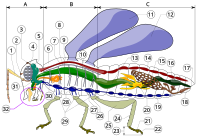
Photo from wikipedia
BACKGROUND The optimal technique for arthroscopic rotator cuff repair is still controversial. Large tears with a high grade of retraction have an especially high risk of retearing. This study reports… Click to show full abstract
BACKGROUND The optimal technique for arthroscopic rotator cuff repair is still controversial. Large tears with a high grade of retraction have an especially high risk of retearing. This study reports the clinical and radiologic results of a triple-row modified suture bridge technique for the treatment of full-thickness rotator cuff tears with medium and high grades of retraction. METHODS A total of 101 shoulders in 100 patients underwent a triple-row modified suture bridge reconstruction for full-thickness rotator cuff tears with retraction grade II and grade III according to Patte; 81 patients were reached for follow-up 36.2 months after surgery. At follow-up, clinical outcome was assessed by the American Shoulder and Elbow Surgeons score, subjective shoulder value, visual analog scale score, University of California-Los Angeles shoulder score, and Constant score (CS). At follow-up, an ultrasound examination was performed to determine tendon integrity or retears in all patients. RESULTS The overall retear rate was 4.9% (4/81). The clinical outcome was good to excellent (American Shoulder and Elbow Surgeons score, 94 ± 11; subjective shoulder value, 92 ± 12; University of California-Los Angeles shoulder score, 33 ± 5; Constant score, 90 ± 9). In the radiologic follow-up, no retear was found in any of the follow-up patients after an average of 36.2 months. There was no significant difference in clinical outcome parameters between rotator cuff tears Patte II and Patte III (P > .05). CONCLUSION For tears with a high grade of retraction, surgical treatment using a triple-row modified suture bridge technique represents a good treatment option with a low rate of retearing and good to excellent clinical results.
Journal Title: Journal of shoulder and elbow surgery
Year Published: 2019
Link to full text (if available)
Share on Social Media: Sign Up to like & get
recommendations!